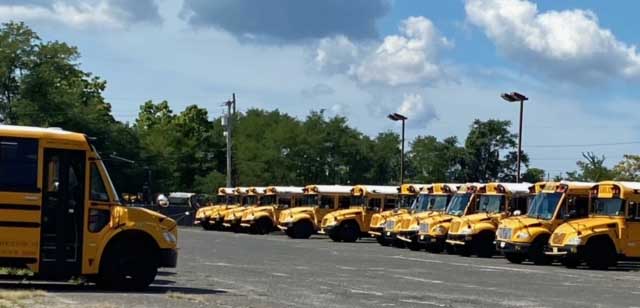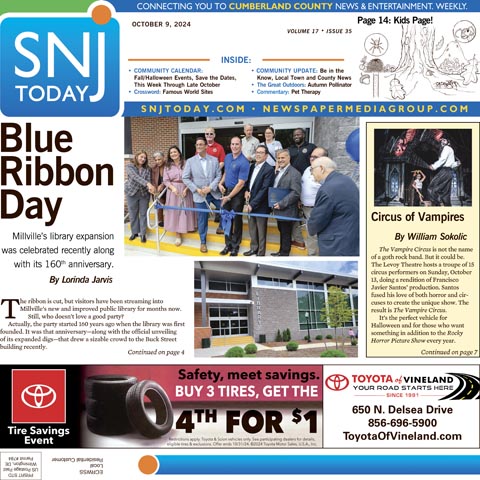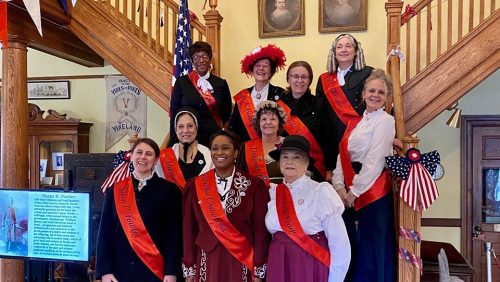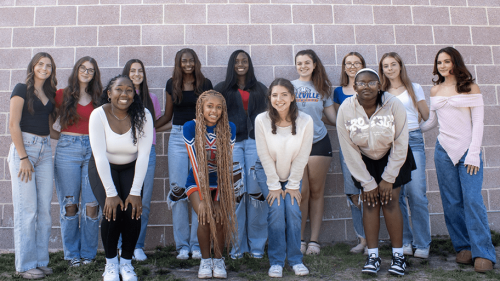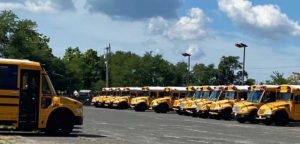 Nothing marks the beginning of school like the return of yellow school buses to our streets. Local school officials as well as commuters hope that all students who are offered bus service will take advantage of it.
Nothing marks the beginning of school like the return of yellow school buses to our streets. Local school officials as well as commuters hope that all students who are offered bus service will take advantage of it.
School districts across the country experienced a huge shift during COVID.
“A higher number of parents were transporting students to school. We’re expecting more kids on the bus this year,” says Meg Finney, public information officer at Millville Public School.
She points out that it is safer for kids to be on the bus: “The National Highway Traffic Safety Administration says students are 70 times more likely to get to to school safely on a bus. Buses are very regulated. They are designed for public safety. We definitely want them to use the service.”

It was challenging at the schools to handle the influx of drivers. “There are specific procedures in place at each school to make it as organized as possible,” Finney explains. “But some parents were sitting in line for an hour before school let out. That is a time commitment when using your own vehicle. You wouldn’t have to worry about it if they are using the service we provide.”
The same is true in Vineland. Mike Hall, director of transportation with Vineland Public Schools, is hopeful about the school year being better now that COVID is more under control.
“We had some serious bottlenecks as we had more parents transporting kids. We had many more cars on the property than we’ve ever had. The traffic was more than we could handle,” Hall says.
At the high school, traffic backed up to Main Road, a mile and a half away. The middle school traffic crept for a mile as well. Picking up was also a mess, starting an hour before school let out.
“I think we’re going back to normal ridership,” he says. “That’s what we’re anticipating.”
That is good news all around.
Maria L. Santiago, a bus driver who has been transporting Millville kids safely for more than 20 years, says she is ready.
“You get excited for the first day,” she says. “I’ve got my Lysol, my gloves, my wipes, my hand sanitizer. I’ve got the glass cleaner. I mop the floors, too. I put name tags up.”
 Santiago drives special-needs and behavioral disorder kids, making her route longer than most, and she also has an aide. She clearly loves it and mixes in good advice with safe driving. “You get attached. If my kids have a bad day, I tell them to get a shower, do your chores. Tomorrow is a fresh day. We start again.”
Santiago drives special-needs and behavioral disorder kids, making her route longer than most, and she also has an aide. She clearly loves it and mixes in good advice with safe driving. “You get attached. If my kids have a bad day, I tell them to get a shower, do your chores. Tomorrow is a fresh day. We start again.”
Leah Depasquale, a driver starting her fourth year in Millville, also refers to her riders as “my kids.” Like other drivers, she runs the same route each day, first picking up high school students and taking them to school, then middle schoolers on that same route, then the elementary students. After school she returns the students home in the same order. Her route stays the same year to year.
“I like seeing all my kids. Kids who started with me in Kindergarten are now in 4th grade,” Depasquale says. “Some I’ve had for years and then a little brother or sister comes on the bus.”
Depasquale decorates her bus monthly for the kids.
Santiago and Depasquale meet up at Sheppard Bus Service’s headquarters in Millville. Sheppard provides the bus service for the Millville schools. This is go-time.
Cindy Carter, chief of operations at Sheppard, says drivers have “their route sheets. They are running dry routes [empty buses]. Consistency with our drivers is key. They get to know their children and their families.”
Owners John and Kelly Sheppard are second generation in this 70-year-old family-run business with more than 700 employees. In addition to the 500-plus school vehicles in five terminals in the state, they also operate a fleet providing other transportation services.
 There are about 5,000 students in the Millville schools, most of them riding buses to school. Later this week, Millville will be distributing bus passes through the parent portal.
There are about 5,000 students in the Millville schools, most of them riding buses to school. Later this week, Millville will be distributing bus passes through the parent portal.
Finney offers these tips. “Once you know where your bus stop is, check it out ahead of time. Take three giant steps back so you’re six feet away from the curb.”
She reminds students this is “not a place to be goofing around. Everything should be packed up. This is not the time to be going through your backpack, not trying to finish up homework or to be on the phone. Practice good pedestrian safety. Never walk behind a bus. If walking in front, walk at least 10 feet in front of it. Always wait for the bus to stop. We have procedures for getting on and off the bus. It is a learning process for some.”
Students will need to show bus passes to drivers. “It’s part of getting acclimated to the school year,” Finney explains. “When you get on the bus, find a seat quickly. Get buckled. Stay seated; don’t lean over seats. Have all your belongings with you. Listen to the bus driver. All buses are equipped with cameras for safety.”
Her advice to parents is to get to know their kids’ bus driver: “Drivers are learning routes. Have some grace and patience, like anything else at the start of a school year, there might be little kinks to work out.”
Hall shares Vineland’s numbers: “We have just north of 11,000 students, close to 9,000 ride school buses. There are 23 schools, 160 school buses.”
 Vineland has its own buses. “We’re having our drivers personally disinfect their own buses. It kills germs and so forth,” he says. “After every morning run, they will wipe down or spray down.”
Vineland has its own buses. “We’re having our drivers personally disinfect their own buses. It kills germs and so forth,” he says. “After every morning run, they will wipe down or spray down.”
Like the rest of the country, Vineland faced staffing shortages but found a game changer in running their own training center.
“In November we started our own CDL,” Hall continues. “We have four trainers. Before, drivers had to come in with a license. Now we can teach you all the way.”
Bus drivers-in-training have 20 hours of classroom training and 25 to 40 hours on the road. “We’re in great condition. I’m looking forward to getting started,” Hall says.
Both Sheppard bus drivers interviewed for this story are protective of their precious cargo. They want the public to be too. “Stop when these red lights are flashing. I need people to stop,” says Depasquale emphatically. She asks drivers to drive as if it were their own kids on the bus.

